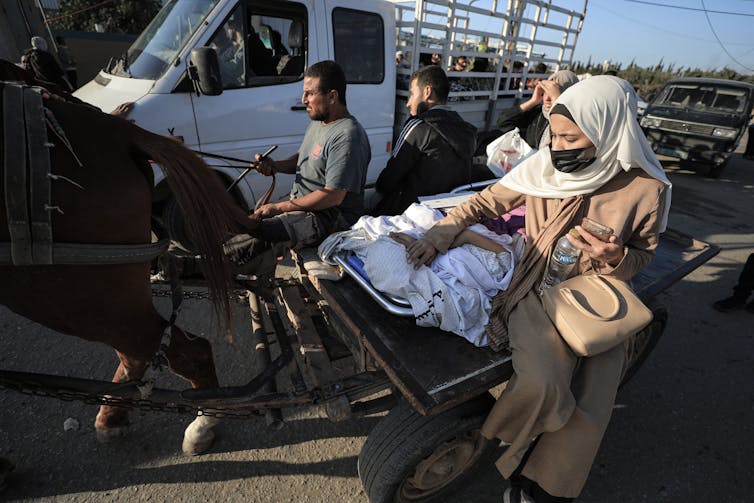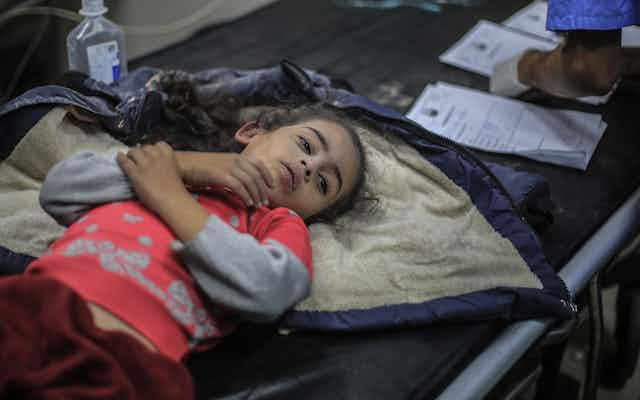After more than a month of being subjected to sustained bombing, the besieged people of the Gaza Strip are now confronted with another threat to life: disease.
Overcrowding at shelters, a breakdown of basic sanitation, the rising number of unburied dead and a scarcity of clean drinking water have left the enclave “on the precipice of major disease outbreaks,” according to the World Health Organization.
As an expert in Palestinian public health systems who wrote about the many relationships between war and health for my forthcoming book “How War Kills: The Overlooked Threats to Our Health,” I believe that the looming crisis cannot be underestimated. The easy spread of infectious disease in wartime conditions can be just as devastating as airstrikes to health and mortality – if not more so. Health care services in Gaza – already vulnerable prior to the Israeli bombing campaign – have essentially no capacity to cope with a major outbreak.
Disease already rampant
History has proved time and again that war zones can be a breeding ground for disease. Anywhere impoverished and underresourced people crowd for shelter or access to resources – often in facilities with inadequate living conditions, sanitation services or access to clean water – is prone to the spread of disease. This can be through airborne or droplet transmission, contaminated food or water, living vectors like fleas, mosquitoes or lice, or improperly cleaned and managed wounds.
In any situation of armed conflict or mass displacement, the threat of infectious disease is among the primary concerns of public health professionals. And from the outset of the Israeli bombing campaign, experts have predicted dire health consequences for Gaza.
After all, the Gaza Strip had fragile health and water, sanitation and hygiene sectors long before the Oct. 7, 2023, Hamas attack that killed 1,200 Israelis and prompted the retaliatory airstrikes. The health system of Gaza, one of the most densely populated places in the world, has long been plagued by underfunding and the effects of the blockade imposed by Israel in 2007.
Waterborne illness was already a major cause of child mortality – the result of the contamination of most of Gaza’s water. In early 2023, an estimated 97% of water in the enclave was unfit to drink, and more than 12% of child mortality cases were caused by waterborne ailments, like typhoid fever, cholera and hepatitis A, that are very rare in areas with functional and adequate water systems.

Other forms of infectious disease spread have also been reported in recent years. Gaza had experienced several previous outbreaks of meningitis – an inflammation of the tissues surrounding the brain and spinal cord typically caused by infection – notably in 1997, 2004 and 2013.
In late 2019, a small outbreak of measles – a highly contagious, airborne virus – was reported in Gaza, with almost half of reported cases in unvaccinated people. Despite a relatively high vaccination rate in Gaza generally, these gaps in vaccination and the inability to respond quickly to outbreaks were attributed by the WHO to “the continuous socio-economic decline since 2009, conflict, and closure.”
And the COVID-19 pandemic hit the Gaza Strip hard, exacerbated by the Israeli blockade that prevented or delayed the import of vital personal protective equipment, testing kits and vaccines.
A system overwhelmed
The vulnerability of Gaza’s health care meant that from the outset of the latest conflict, organizations such as the WHO voiced concern that the violence and deprivation could quickly overwhelm the system.
There are several ways war in general, and the conflict in Gaza in particular, accelerates and promotes infectious disease risk.
Almost concurrently with the start of the bombing campaign, Israel imposed siege conditions on Gaza. This prevented the import of fuel needed to run generators for vital infrastructure. Generators are needed because Israel shut off electricity to Gaza.
As fuel has essentially run out in recent days, this has meant no power for desalination plants or for solid waste collection. As a consequence, many people have been forced to consume contaminated water or live in conditions where living carriers of disease, like rodents and insects, thrive.
Even basic cleaning supplies are scarce, and equipment used to sterilize everything from medical equipment to baby bottles is inoperable.
These unhygienic conditions come as hundreds of thousands of Palestinians in Gaza attempt to flee the bombing to the few remaining places left to shelter. This has caused massive overcrowding, which increases the risk of an infectious disease outbreak.
Children especially vulnerable
Already, the WHO has reported worrying trends since mid-October 2023, including more than 44,000 cases of diarrhea in Gaza.
Diarrhea is a particular risk for young children who are prone to profound dehydration. It represents the second-leading cause of death worldwide in children younger than 5 years of age. Half of the diarrhea cases reported in Gaza since the Israeli bombing campaign began have been in children under 5.
Meanwhile, nearly 9,000 cases of scabies – a skin rash caused by mites – have been reported, as have more than 1,000 cases of chickenpox.
More than 70,000 cases of upper respiratory infections have been documented, far higher than what would be expected otherwise. These are just cases that were reported; undoubtedly, more people who were unable to get to a health facility for diagnosis are also sick.
Reports of the spread of chickenpox and upper respiratory infections like influenza and COVID-19 are particularly dangerous considering children’s vaccination schedules are being highly disrupted by conflict. With health services overstretched and the mass movement of families, young children and newborns are likely going without vital, lifesaving inoculations just as winter – the peak season for respiratory infections – arrives.
Upper respiratory infections are also exacerbated by the amount of dust and other pollutants in the air due to the destruction of buildings during bombing.
Then there is the direct impact of the bombing campaign. A lack of antibiotics – due to both the siege and the destruction of health facilities – means physicians are unable to adequately treat thousands of patients with open wounds or in need of medical operations, including amputations.
More death and suffering
Increasingly, doctors are even running out of wound dressings to protect injuries from exposure. Poor infection prevention controls, high casualty rates and high concentrations of toxic heavy metals, among other factors, are leading to reports of antimicrobial resistance, which occurs when bacteria and viruses evolve over time to no longer respond to antibiotics and other antimicrobial medications. This has the potential to lead to health issues long after the bombing stops. Similar trends were also seen in Iraq, where antimicrobial resistance rates remain high despite the peak of bombing campaigns ending many years ago.
And with many bodies laying under rubble, unable to be retrieved, and the necessity of digging multiple mass graves near sites where people are sheltering, there is also increased risk of disease arising from an inability to adequately dispose of the dead.
While the images and photos from Gaza of areas and people that have been bombed are devastating and have caused a massive death toll – at least 12,000 by mid-November, according to Gaza health authorities – the rapid spread of infectious disease has the ability to cause even greater mortality and suffering to a population reeling from weeks of sustained bombing.

